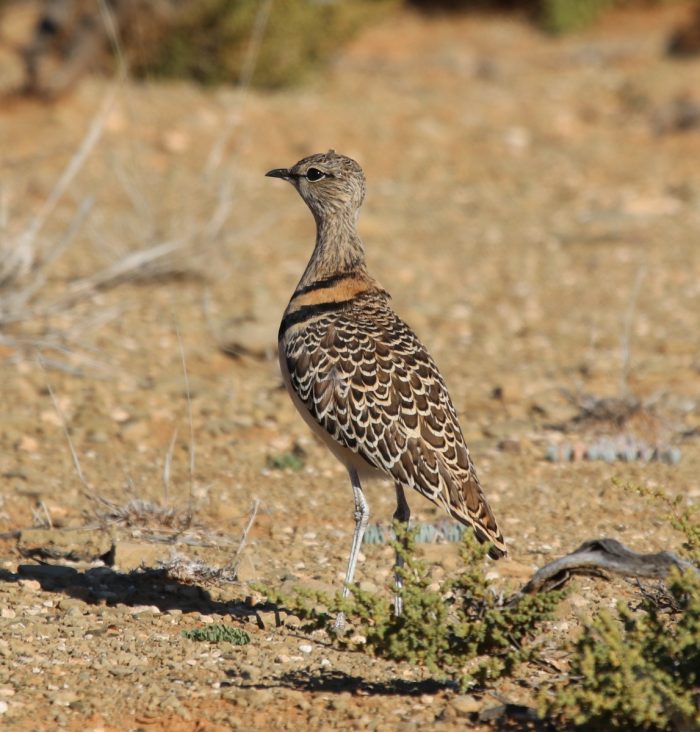Cover image of Double-banded Courser by Desire Darling – Mountain Zebra National Park, Eastern Cape – BirdPix No. 52169
Identification
The Double-banded Courser is a small, pale coloured species. Its most distinctive feature is the two narrow black bands across the breast, which are diagnostic. The undersides are pale sandy or cream coloured. The upper sides are sandy brown with white edging to the feathers, giving a scaled appearance. The neck is slightly darker with fine vertical streaking. The crown is plain and there is a prominent cream-coloured supercilium. The long legs are pale whitish.
The sexes are alike.

Photo by Janet du Plooy
In flight shows distinctive rust-coloured secondaries and inner primaries and white uppertail coverts (see the photograph below).
Juveniles are similar to the adults but have chestnut breastbands and a less well-defined supercilium.

Double-banded Courser (Rhinoptilus africanus) – Carnarvon district, Northern Cape
Photo by Ryan Tippett
Distribution
The Double-banded courser is widespread and found in three separate populations, in southern Africa, East Africa and north-east Africa. In South Africa it occurs mainly in the arid western and central regions.

Habitat
This is a species of flat plains with low, sparse vegetation and bare open areas. It is often found in stony places and dry pans. It is partial to pale calcrete gravel and is most numerous in Nama Karoo shrublands, arid grasslands and the Kalahari. The species also occurs in sparse Mopane scrub in northern Botswana and Namibia.

Double-banded Courser (Rhinoptilus africanus) – Carnarvon district, Northern Cape
Photo by Sybrand Venter
Behaviour
The Double-banded Courser feeds on a range of insects and is especially fond of Harvester Termites. It forages by pecking at the ground after running a short distance. This species may be found solitarily, in pairs or in small groups of three to four birds.
Breeding may take place at anytime of the year. One egg is laid per clutch, either in a shallow scrape on directly on the substrate. The nest site is often lined with small stones, sheep or antelope droppings or bits of dried plant matter.

Double-banded Courser (Rhinoptilus africanus) – Steytlerville District, Eastern Cape
Photo by Dave Brown
The egg is incubated by both parents for 26 to 27 days. Chicks are known to fledge five to six weeks after hatching. They are fed by both parents.
The Double-banded Courser is known to be highly nomadic throughout its range and it appears to be most numerous during dry conditions.

Photo by Tino Herselman
Further Resources
Species text from the first Southern African Bird Atlas Project (SABAP1), 1997.
The use of photographs by Dave Brown, Desire Darling, Janet du Plooy, Sybrand Venter and Tino Herselman is acknowledged.
Virtual Museum (BirdPix > Search VM > By Scientific or Common Name).
Other common names: Dubbelbanddrawwertjie (Afrikaans): Segolagola (Tswana); Dubbelbandrenvogel (Dutch); Courvite à double collier (French); Doppelband-Rennvogel (German).
Recommended citation format: Tippett RM 2023. Double-banded Courser Rhinoptilus africanus. Biodiversity and Development Institute. Available Online at http://thebdi.org/2023/01/23/double-banded-courser-rhinoptilus-africanus/

Photo by Desire Darling

